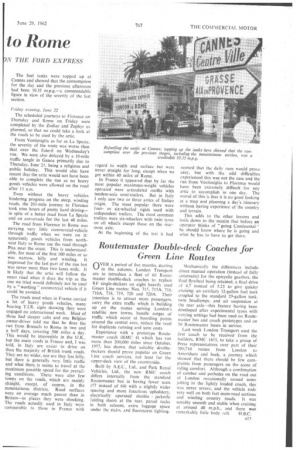Routemaster Double-deck Coaches for Green Line Routes
Page 57

If you've noticed an error in this article please click here to report it so we can fix it.
OVER a period of five months, starting in the autumn, London Transport are to introduce a fleet of 68 Routemaster double-deck coaches to replace RF single-deckers on eight heavily used Green Line routes: Nos. 715, 715A, 716, 716A, 718, 719, 720 and 720A. Their intention is to attract more passengers. carry the extra traffic which is building up on the routes serving London's satellite new towns, handle surges of traffic which occur at boarding points around the central area, reduce the need for duplicate running and save costs.
Experience with a prototype Routemaster coach (RMC 4) which has run more than 200,000 miles since October. 1957, has shown that suitable doubledeckers should prove popular on Green Line coach services, not least for the upper-deck view of the countryside_
.Built by A.E.C., Ltd.. and Park Royal Vehicles, Ltd., the new RMC coach differs internally from the standard Routemaster bus in having fewer seats (57 instead -of 64) with a slightly 'wider spacing and more luxurious upholstery, electrically operated double jacknife folding doors at the rear, parcel racks in both saloons, extra luggage space under the stairs. axcl fluorescent lighting.
Mechanically the differences include direct manual operation (instead of fully automatic) for the epicyclie gearbox, the fluid flywheel being retained, a final drive of 4.7 instead of 5.23 to give quieter cruising, an auxiliary 12-gallon fuel tank coupled to the standard 29-gallon tank, twin headlamps, and air suspension at the rear axle—this feature having been developed after experimental types with varying settings had been used on Routemaster bus and coach prototypes and on 50 Routemaster buses in service.
Last week London Transport used the first coach to be received from the builders, RMC 1453, to take a group of Press representatives over part of their 709/710 routes from London to Amersham and back, a journey which showed that there should be few complaints from passengers on the score of riding comfort. Although a combination of camber and potholes on the road out of London occasionally caused some jolting in the lightly loaded coach, this was never severe, and the vehicle rode very well on both fast main-road sections and winding country roads. It was notably smooth and stable when cruising at around 40 m.p.h., and there was
remarkably little body roll. H.B.C.
















































































































































